views
Do you know? Around 0.005% to 0.014%, i.e. ( 1 in 10,000) of people assigned male at birth, and 0.002% to 0.003%, i.e. (3 in 100,000) of people assigned female at birth, are diagnosable with gender dysphoria. And one of the surveys shows that, Out of 55 patients, 41 reported feeling GD for the first time by age 6, and the left reported experiencing GD by age 13. 80% of patients said that feelings of GD were among their earliest childhood memories. People with gender dysphoria may feel trapped in a body that does not match their true identity and struggle with gender expression and presentation. It is essential to note that gender dysphoria is not a mental illness and is not caused by any personal failing or deficiency. Then you must be wondering, what is gender dysphoria, what are the causes of gender dysphoria in adults, how can it be treated and many such questions must be running in your mind right now, isn't it? Get all the answers here!
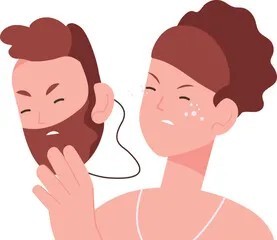
Overview
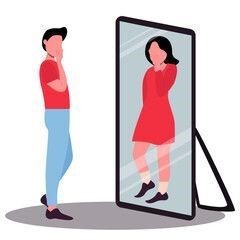
Gender dysphoria is a condition in which a person experiences significant distress because the sex and gender assigned at birth do not match their gender identity.
This can cause various adverse emotional and mental health effects, including depression, anxiety, and difficulty functioning daily.
It is essential for people with gender dysphoria to be treated with respect and acceptance and to have access to appropriate medical and mental health care.
This blog will see its causes, symptoms, types, diagnosis, and how it could be managed.
Causes of Gender Dysphoria in adults
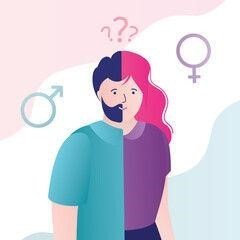
The exact cause of gender dysphoria is not fully understood.
Research suggests that a combination of genetic, hormonal, and environmental factors may contribute to the development of gender dysphoria.
No evidence suggests that parenting or socialization practices cause gender dysphoria. Gender dysphoria is a profoundly personal and individual experience, and any one factor does not cause it.
Some potential contributing factors to the development of gender dysphoria in adults may include -
● Biological differences in the brain: There is some evidence to suggest that there may be differences in the brain structure and function of individuals with gender dysphoria compared to those who do not experience this condition.
● Hormonal influences: Hormonal imbalances during fetal development or puberty may contribute to the development of gender dysphoria.
● Environmental influences: Some research suggests that social and cultural effects, such as how a person is raised and the expectations placed on them based on their sex assigned at birth, may contribute to the development of gender dysphoria.
It is important to note that there is no one "cause" of gender dysphoria and that each person's experience is unique.
Are you or your loved ones experiencing gender dysphoria and are seeking support?
In that case, it may be helpful to speak with a mental health professional trained in working with individuals with gender dysphoria.
They can provide guidance and support as you navigate your unique experience.
Still confused about whether you are diagnosed with Gender Dysphoria?
Let's discuss the signs and symptoms!
Gender Dysphoria symptoms in adults
The signs of gender dysphoria in adults can vary widely from person to person.
Still, some common signs and symptoms may include the following:
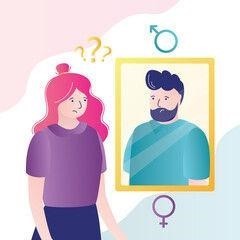
● A strong sense of disconnection from one's body, especially the primary and secondary sex characteristics (such as the genitals, breasts, and facial hair).
● A desire to hide or change one's primary and secondary sex characteristics.
● A desire to be treated as a member of the opposite gender or to be referred to by pronouns or a name associated with the opposite gender.
● A feeling of discomfort or distress when expressing or experiencing gender-related behaviors, activities, or roles traditionally associated with one's assigned gender.
● A sense of pain or distress when being referred to by pronouns or a name with one's assigned gender.
People with gender dysphoria may also experience various mental health symptoms, including depression, anxiety, and suicidal thoughts.
It is also essential to recognize that gender dysphoria is a normal and natural variation of human experience and is not a mental illness.
People with gender dysphoria need support from a mental health professional who can help them manage their emotions and provide support as they navigate their gender identity.
So, are you experiencing one or more of the above symptoms just discussed?
Call today and get free Consultation!
Disclaimer: It is important to note that these symptoms can vary in intensity and frequency and that not all people with gender dysphoria experience all of these symptoms.
Types of Gender Dysphoria in Adults

Gender dysphoria is a spectrum disorder, and individuals may experience various symptoms and desires.
Some individuals may experience a strong desire to transition to the opposite gender, while others may experience a mild or more fluctuating sense of discomfort with their gender.
Did you know that there are several types of gender dysphoria that can affect adults?
Some of them are as follows.

|
Types |
Meaning |
|
Body Dysphoria: |
● Body dysmorphic disorder is an anxiety disorder in which sufferers obsess over their looks. ● These people also have a misperception of how they appear. ● Body dysphoria can develop in people with other mental health conditions, such as severe depression and anxiety. |
|
Social Dysphoria: |
● The misery and discomfort brought on by how society perceives a person is known as social dysphoria. ● A few contributing variables are when someone else guesses a person's gender, uses the wrong pronouns or assumes certain societal norms pertaining to gender. |
|
Mind Dysphoria: |
● Mind dysphoria refers to a person having feelings associated with their assigned gender or the one to which they no longer relate. ● Older patients typically encounter it. ● An illustration might be someone who claims to be a man yet has PMS symptoms. They don't want to experience these feelings.
|
It is important to note that these types of gender dysphoria are not mutually exclusive, and a person may experience more than one type simultaneously.
It is also essential to recognize that every person's experience with gender dysphoria is unique.
Diagnosis of gender Dysphoria in adults

The diagnosis of gender dysphoria in adults typically involves a thorough evaluation by a mental health professional, such as a psychologist or psychiatrist.
This evaluation may include a physical examination, a review of the person's medical and mental health history, and a discussion of their feelings, experiences, and behaviors related to their gender identity.
The criteria for diagnosing gender dysphoria in adults are outlined in the Diagnostic and Statistical Manual of Mental Disorders (DSM-5).
To receive a diagnosis of gender dysphoria, an adult must meet the following criteria:
● A marked incongruence between one's experienced/expressed gender and assigned gender.
● A persistent desire to be of the other gender or insist that one is the other gender.
● A strong desire to be rid of one's primary and secondary sex characteristics
● A strong desire for the primary and secondary sex characteristics of the other gender.
● A strong desire to be treated as the other gender
● A muscular discomfort with one's gender or gender roles.
A mental health professional will consider all of these factors, as well as any other relevant information when making a diagnosis of gender dysphoria in an adult.
Are you or your loved one diagnosed with gender dysphoria?
Do not worry! There is no problem without a solution!
Below we have mentioned some of the treatment options for gender dysphoria in adults.
Treatment for gender dysphoria in adults
Yes, gender dysphoria in adults can be managed through various approaches, such as follows-
● Medical intervention,
● Mental health treatment,
● And social transition.
The specific treatment plan will depend on the individual's needs, preferences, and goals and may involve a combination of different approaches.
Let's check out the different approaches to managing gender dysphoria in detail.
Medical interventions for gender dysphoria in Adults in Transmen may include

|
Hormone therapy |
● Which involves taking hormones such as testosterone to help promote physical changes associated with the gender that a person identifies with. |
|
Surgery |
● Some people with gender dysphoria may choose to have surgery to alter their physical appearance to match their gender identity. ● This can include top surgery (breast reduction or chest masculinization) and bottom surgery (vaginectomy, hysterectomy, and phalloplasty or metoidioplasty). |
|
Mental health treatment |
● Working with a therapist or counselor can be beneficial for people with gender dysphoria, ● As they can help individuals explore their gender identity and cope with any related distress. |
Medical interventions for gender dysphoria in Adults in Transwomen may include:
|
Hormone therapy |
● This involves taking hormones such as estrogen and progesterone to help promote physical changes associated with the gender that a person identifies with. |
|
Surgery |
● Some people with gender dysphoria may choose to have surgery to alter their physical appearance to match their gender identity. ● This can include top surgery (breast augmentation) and bottom surgery (vaginoplasty). |
|
Mental health treatment |
● Working with a therapist or counselor can be beneficial for people with gender dysphoria, ● As they can help individuals explore their gender identity and cope with any related distress. |
Further talking about hormone therapy, Gregory Quayle, an ABMS-certified urologist from Mississippi with 14 years of experience and an advisory board member at Phoenix says, “Hormone therapy is an effective treatment for gender dysphoria in adults. Research on the effectiveness of hormone therapy for gender dysphoria has found that it can be a highly effective treatment, with an estimated success rate of over 80%. This is largely due to the physical changes that can happen as a result of hormone therapy, such as increased body fat distribution and changes in secondary sex characteristics, which can help reduce feelings of gender dysphoria. Additionally, hormone therapy can help reduce depressive symptoms, anxiety, and suicide ideation.”
Some common therapies for transmen and transwomen in Dysphoria in adults are:
Individual therapy
● Can provide a supportive space for individuals to explore their gender identity and decide their gender expression and presentation.
● It can also help individuals cope with the emotional and psychological aspects of their gender dysphoria. Individual therapy involves one-on-one sessions with a mental health professional, such as a psychologist or therapist.
Group therapy
● Involves participating in therapy sessions with a group of people exploring their gender identity.
● Group therapy can provide a sense of community and support and can be an essential resource for people with gender dysphoria.
Social transition
● Social transition refers to changing one's name, pronouns, and outward appearance (such as hairstyle and clothing) to better align with gender identity.
● Social transition can be a powerful way for individuals to assert their gender identity and can often lead to improved mental health and well-being.
It is essential for people with gender dysphoria to work with a supportive healthcare provider who can help them explore their options and make informed decisions about their treatment.
It is also essential for individuals to access a network of supportive friends, family, and community members who can provide emotional support and acceptance.
Wait!
Don't you want to know what happens if it's left untreated?
Continue reading to know more.
What if gender dysphoria in adults is left untreated?
Research has shown that people with gender dysphoria who do not receive appropriate treatment and support are more likely to experience mental health problems and have a lower quality of life.
If untreated, gender dysphoria in adults can negatively impact mental health and well-being.
People with gender dysphoria may experience various negative emotions, such as
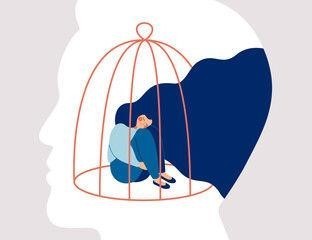
● Sadness,
● Depression,
● Anxiety,
● And frustration.
They may also experience social isolation, difficulty functioning daily, and difficulty maintaining relationships.
Untreated gender dysphoria can also increase the risk of mental health problems, such as depression, anxiety, and suicidal thoughts.
Thus, it becomes important for people with gender dysphoria to seek treatment and support from a healthcare professional who can help them manage their condition and improve their mental health and well-being.
So, what are you thinking?






















Comments
0 comment